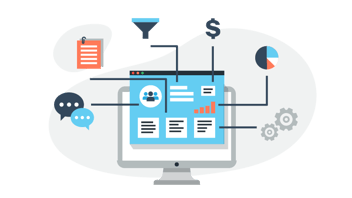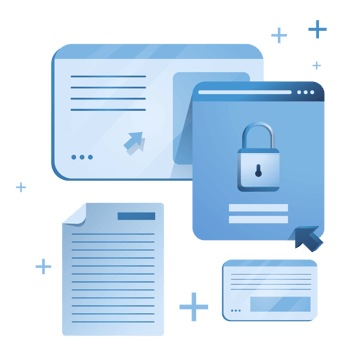De ce Inbound Marketing? Cum să maximizați generarea de lead-uri
Imaginează-ți că navighezi pe un site de știri și ești prins la curent cu rezumatul zilnic al titlurilor de astăzi. Tocmai ați făcut clic pe un articol care v-a stârnit interesul. Apoi, dintr-o dată, sunteți întrerupt brusc de o reclamă video pop-up. În următoarele 20 de secunde, veți fi foarte enervat și veți aștepta cu nerăbdare dispariția anunțului. Cu toții am trecut prin asta.
Este posibil să jurați că nu veți mai apela la acea companie din cauza reclamei sale intruzive și să promiteți că nu le veți mai oferi niciodată serviciile dumneavoastră. Această strategie de publicitate ca o încercare de a genera clienți potențiali contravine metodei inbound marketing de a atrage clienți potențiali într-un mod cât mai puțin invaziv.

Generarea de lead-uri este considerată o prioritate absolută pentru marketeri și, de fapt, 61% spun că generarea de trafic și de lead-uri este principala lor provocare. HubSpot definește generarea de lead-uri:
Generarea de lead-uri atrage și convertește străini și potențiali clienți în persoane care au manifestat un interes pentru produsul sau serviciul companiei dvs.
Câteva exemple de generatori de lead-uri sunt cererile de angajare, postările pe blog, cupoanele, evenimentele live și conținutul online.
Din întâmplare, marketingul inbound și generarea de lead-uri merg mână în mână. Scopul inbound este de a crea un flux constant de vizitatori interesați de site-ul dvs. web, care este un prim pas esențial în crearea de clienți potențiali care pot fi transformați în clienți. Întrebarea care se pune întreprinderilor este următoarea: odată ce ați obținut un trafic web constant, cum transformați acești vizitatori în clienți potențiali? Cum îi mențineți pe consumatorii interesați implicați și revenind pe site-ul dvs. până când (și chiar după) apasă pe trăgaci și fac o achiziție?
Creați un calendar editorial având în vedere pâlnia de vânzări.
Având un calendar organizat, orientat către criteriile buyer personas, vă veți asigura că liderii dvs. nu scapă printre degete. V-ați atras vizitatorii pentru că v-au găsit afacerea, probabil pentru că ați creat conținut captivant care i-a condus la site-ul dvs. și au fost suficient de intrigați pentru a afla mai multe. Vreți să vă asigurați că le mențineți interesul viu, lansând mai mult conținut care îi interesează și chiar încurajându-i să vă contacteze pentru mai multe informații. Poate părea simplu, dar un calendar editorial este o metodă dovedită pentru a vă asigura că postările de pe blog și alte conținuturi sunt mașini de conversie a lead-urilor. Organizarea este cheia pentru a trimite oamenilor conținutul potrivit la momentul potrivit. Informațiile pe care le primesc lead-urile dvs. ar trebui să fie relevante pentru stadiul în care se află în ceea ce privește cunoașterea afacerii dvs. și ar trebui să ofere soluții la problemele lor.
Implementați CTA-urile potrivite
Tipul potrivit de apel la acțiune, sau CTA, vă va menține lead-ul pe linie. O mare parte a marketingului inbound constă în menținerea interesului clienților potențiali pentru ceea ce aveți de spus și, prin aceasta, vă adaptați conținutul pentru a le atrage atenția. De exemplu, un apel la acțiune ar putea fi descărcarea unui ebook pe un subiect legat despre care tocmai au citit pe blogul tău. Alternativ, ar putea fi o modalitate de a programa o întâlnire cu un reprezentant de vânzări pentru a afla mai multe despre serviciul sau produsul dvs. O observație importantă este că CTA-urile dvs. ar trebui să fie legate direct de o pagină de destinație în care este descrisă oferta specială, inclusiv un formular opt-in. Aceasta este una dintre oportunitățile vitale pe care le aveți pentru a capta informațiile de contact ale lead-ului.
Alegeți cuvintele-cheie cu înțelepciune
Nu cred că vreun marketer s-ar opune să obțină o cantitate mare de lead-uri, cu excepția cazului în care aceste lead-uri nu sunt calificate. Captarea de lead-uri necalificate poate fi o pierdere masivă a timpului tău și al lor. Cum vă puteți asigura că obțineți tipul potrivit de clienți potențiali? Cuvintele-cheie pot fi de mare ajutor în eforturile dumneavoastră. Utilizarea cuvintelor-cheie în conținutul blogging-ului vă va asigura că vă stimulați SEO-ul și vă creșteți șansele de a fi găsiți de persoanele care caută cuvintele-cheie incluse în conținutul dvs. În ceea ce privește buyer personas, este esențial să cunoașteți tendințele actuale ale modului în care consumatorul dvs. tipic caută pe internet și cuvintele și frazele pe care le introduce în Google.
Promovați-vă blogurile pe platformele potrivite.
Dacă vă faceți timp să produceți conținut excelent pentru clienții dvs. potențiali și consumatori, doriți să vă asigurați că acesta este văzut. Simpla postare de conținut pe blogul dvs. nu este suficientă și nici nu va crea angajament pentru baza dvs. de clienți potențiali. Postarea blogului dvs. pe diverse platforme, cum ar fi LinkedIn, Facebook și buletinele de știri, vă va extinde raza de acțiune exponențial. Facebook, de exemplu, este o resursă excelentă pentru a face acest lucru, deoarece vă puteți direcționa postările pentru a ajunge la categoriile demografice specifice pe care afacerea dvs. este cea mai interesată să le atingă. Există nenumărate modalități de a rula analize pe postările de pe blog, astfel încât să puteți vedea eficiența generării de clienți potențiali, ceea ce stârnește interesul cititorilor și multe altele. Acestea sunt date neprețuite pentru a rafina conținutul viitor pentru a oferi rezultate constante în ceea ce privește calitatea și cantitatea de clienți potențiali pe care îi primiți.
Blogging-ul este esențial pentru orice strategie inbound și poate servi mai multor scopuri, inclusiv generarea de lead-uri. Având un conținut atractiv și educativ este doar jumătate din bătălie; cealaltă jumătate esteceea ce faceți cu el, adică optimizarea acestuia pentru cele mai bune rezultate de performanță. Generarea de lead-uri este un aspect al strategiei dvs. generale de marketing care se va schimba constant, deoarece comportamentul consumatorilor este în continuă schimbare. Tipul de informații pe care oamenii le caută este în continuă schimbare, la fel și modul în care o fac. Dacă rămâneți în topul tendințelor și rămâneți deschis la această schimbare, plasa dvs. va rămâne plină!
Acest conținut este disponibil și în:
- Germană: Warum Inbound Marketing? Wie man die Lead-Generierung maximiert
- Engleză: Why Inbound Marketing? How to Maximize Lead Generation
- Spaniolă: ¿Por qué Inbound Marketing? Cómo maximizar la generación de leads
- Franceză: Inbound Marketing: Génération de leads
- Italiană: Perché l'Inbound Marketing? Come massimizzare la generazione di lead
- Chineză: 为什么要开展呼入式营销?如何最大限度地挖掘潜在客户









Lasă un comentariu cu părerea ta.